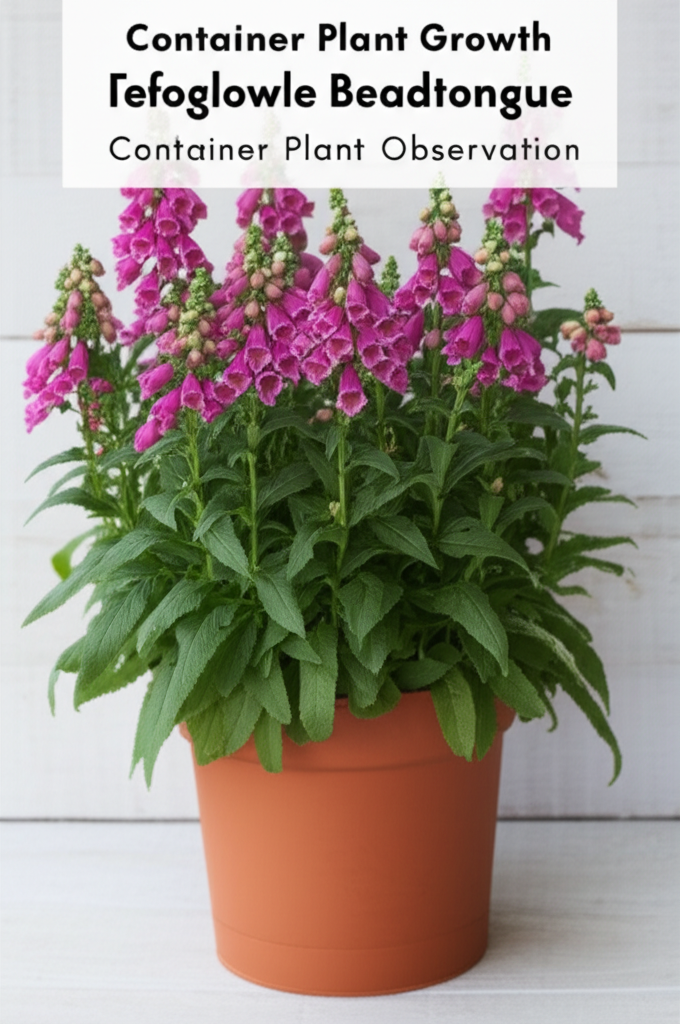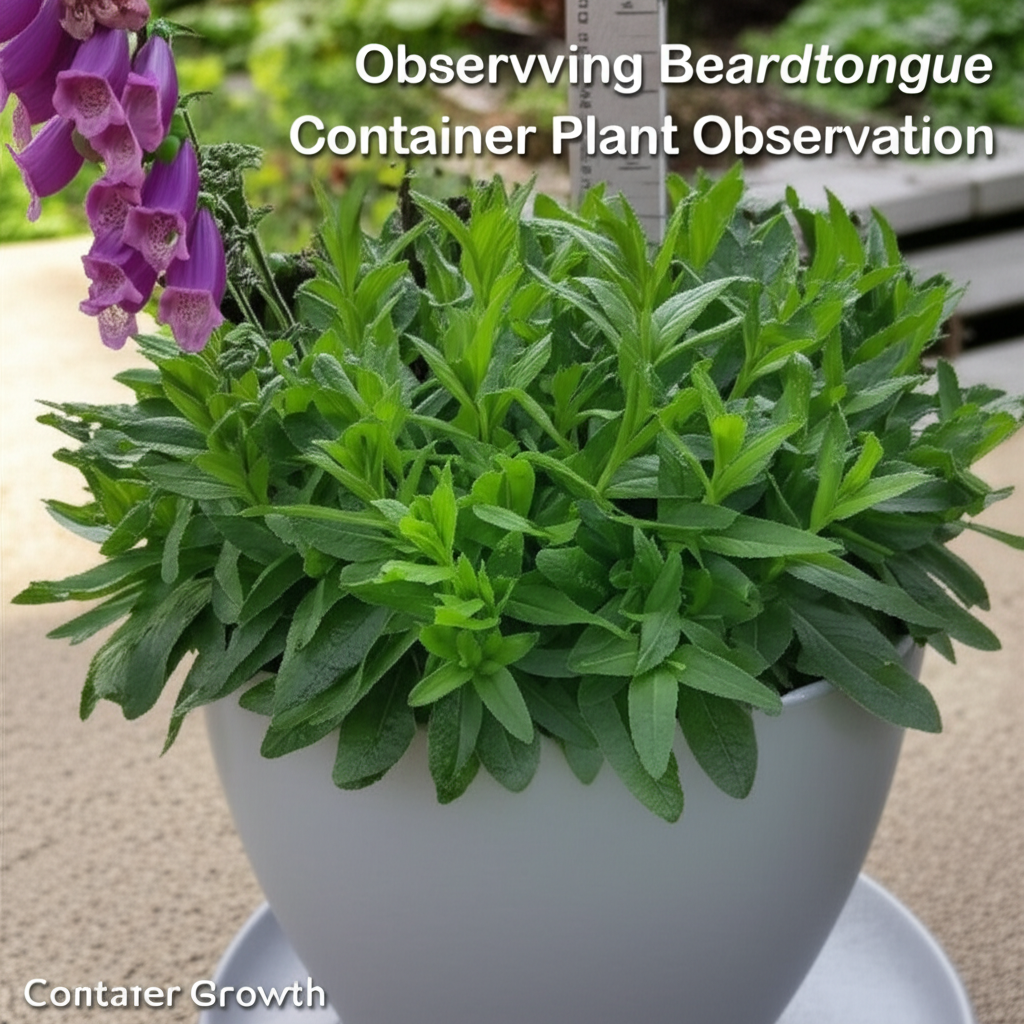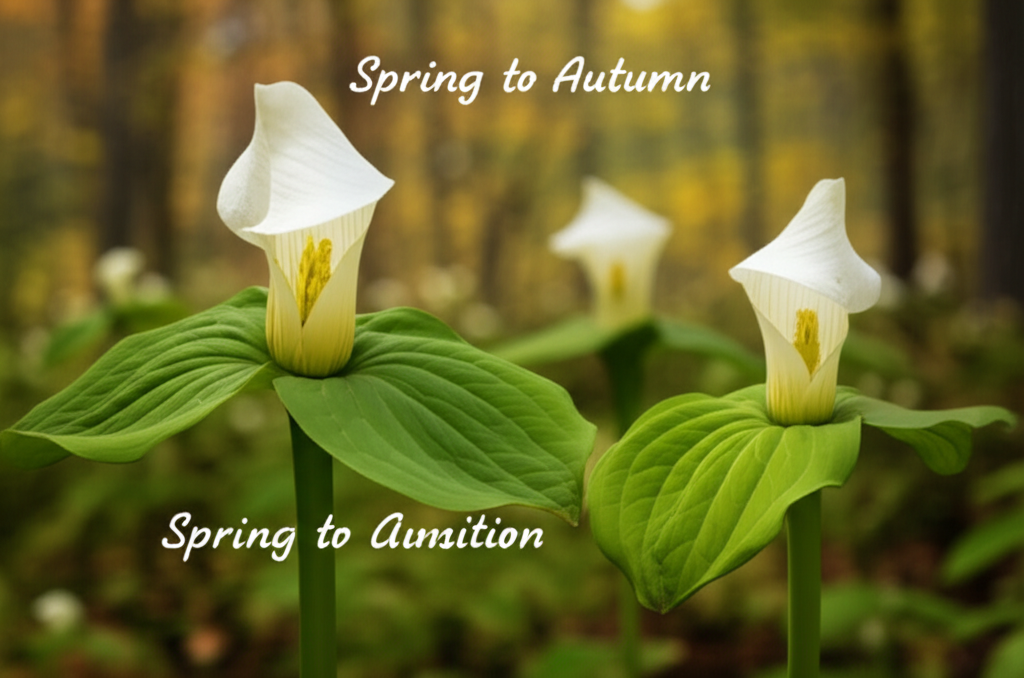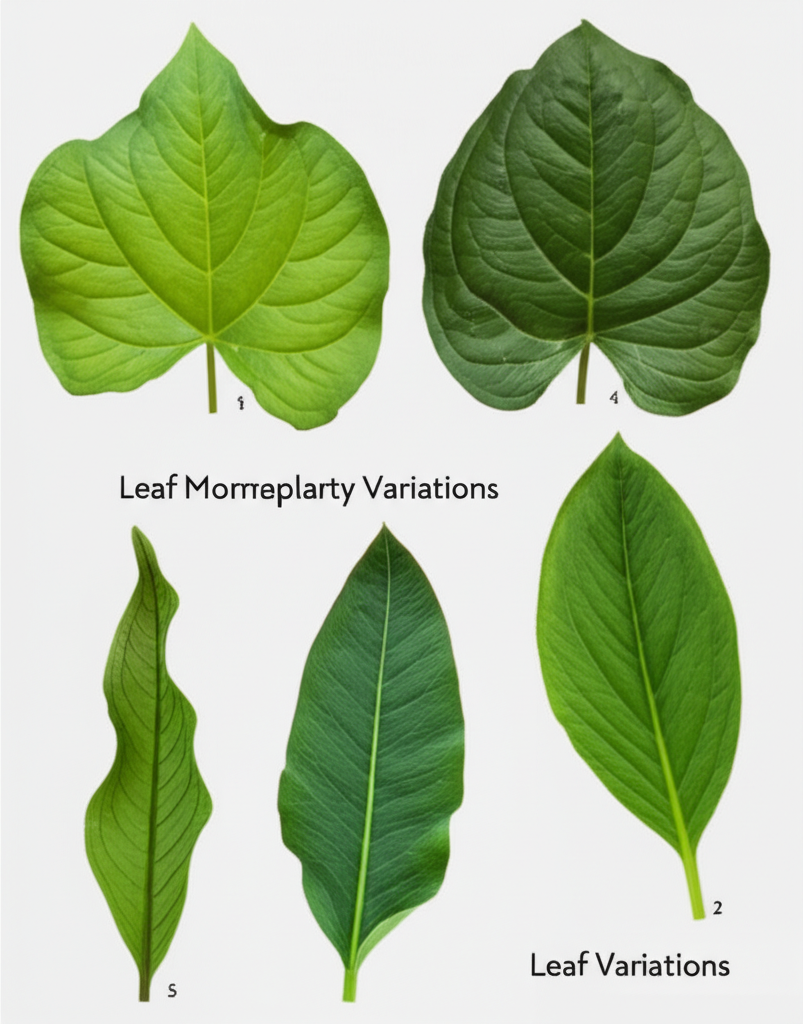Introduction to Foxglove Beardtongue for Container Gardening
Container gardening offers a fantastic opportunity to bring the beauty of native wildflowers into urban spaces, balconies, and patios. Among the many enchanting options, Foxglove Beardtongue (Penstemon digitalis) stands out as a particularly rewarding choice for container cultivation. This hardy and adaptable perennial native to North America boasts a captivating display of tubular, often white or pale lavender flowers that attract a wealth of pollinators, including bees, butterflies, and hummingbirds. Its attractive foliage and upright growth habit make it a striking specimen, even when not in bloom.
This article delves into a comprehensive observation of Foxglove Beardtongue’s growth in a container setting. We will explore the key considerations for successful cultivation, from selecting the right container and soil to providing optimal light, water, and nutrients. Furthermore, we will document its seasonal progression, highlighting its resilience, blooming patterns, and overall performance in a confined growing environment. By understanding its needs and behaviors, gardeners can confidently cultivate this delightful native plant and enjoy its aesthetic and ecological benefits.
Understanding Foxglove Beardtongue (Penstemon digitalis)

Before embarking on container cultivation, it’s essential to understand the fundamental characteristics of Penstemon digitalis. As a member of the Plantaginaceae family, it is renowned for its adaptability to a variety of soil types and its tolerance to both drought and occasional waterlogging, once established.
Key Characteristics:
- Botanical Name: Penstemon digitalis
- Common Names: Foxglove Beardtongue, Smooth Beardtongue, White Beardtongue
- Native Range: Eastern and Central North America
- Mature Height: Typically 2-4 feet (60-120 cm)
- Mature Spread: 1-2 feet (30-60 cm)
- Bloom Time: Late spring to early summer (typically May to June)
- Flower Color: White, pale pink, or pale lavender
- Flower Shape: Tubular, with distinctive “beardtongue” structures
- Sunlight Requirements: Full sun to partial shade
- Soil Preferences: Adaptable, but prefers well-drained soil; tolerates clay and sandy soils
- Drought Tolerance: Moderate to high once established
- Hardiness Zones: 3-8
The “beardtongue” refers to the sterile stamen, often bearded with hairs, which is a characteristic feature of the Penstemon genus. These flowers are not only visually appealing but also perfectly adapted to pollination by long-tongued bees and other beneficial insects.
Container Selection and Preparation
The success of any container plant hinges significantly on the chosen container and its preparation. For Foxglove Beardtongue, several factors are paramount.
Container Size and Material:
Foxglove Beardtongue develops a substantial root system over time. Therefore, choosing a container with adequate space is crucial for long-term health and vigorous growth.
- Minimum Size: For a young plant or a single specimen, a container with a diameter and depth of at least 10-12 inches (25-30 cm) is recommended.
- Mature Plant Considerations: As the plant matures, it may require repotting into a larger container, potentially 14-18 inches (35-45 cm) in diameter.
- Material: Terracotta pots offer good breathability but can dry out quickly. Plastic or glazed ceramic pots retain moisture better. Ensure the container is durable and can withstand seasonal temperature fluctuations. Avoid dark-colored plastic pots in very hot climates, as they can overheat the roots.
Drainage is Key:
As with most plants, especially those that prefer well-drained soil, ample drainage is non-negotiable.
- Ensure the container has at least one large drainage hole, preferably more.
- If the drainage holes are small, consider drilling additional holes or using drainage rocks at the bottom (though this is debated, ensuring good soil structure is more important).
Soil Mix for Container-Grown Beardtongue
The right soil mix provides the necessary support, nutrients, and aeration for the plant’s roots. While Foxglove Beardtongue is adaptable, a well-draining potting mix is essential in a container environment.
Recommended Soil Composition:
A good potting mix should balance moisture retention with excellent drainage.
- Base: High-quality potting soil or a compost-based mix forms the foundation.
- Amendments for Drainage: Incorporate materials like perlite, coarse sand, or small gravel to improve aeration and drainage. A ratio of 2 parts potting soil to 1 part perlite or sand is often effective.
- Compost: Adding a small amount of compost can provide slow-release nutrients and improve soil structure.
- Avoid Heavy Garden Soil: Do not use compacted garden soil directly from the ground, as it can become waterlogged and lacks the necessary aeration for containers.
Planting and Initial Care
The initial planting process sets the stage for the plant’s future development. Careful attention to detail during this phase will yield significant benefits.
Transplanting Procedures:
- Gently remove the Foxglove Beardtongue from its nursery pot.
- Inspect the root ball. If the roots are tightly bound (root-bound), gently tease them apart to encourage outward growth.
- Place the plant in the prepared container, ensuring the top of the root ball is about 1-2 inches (2.5-5 cm) below the rim of the pot.
- Fill the container with the prepared soil mix, firming gently around the root ball to eliminate air pockets.
- Water thoroughly until water drains from the bottom of the pot. This helps settle the soil and hydrate the roots.
Initial Watering and Light:
- Keep the soil consistently moist but not waterlogged during the initial establishment period (first few weeks).
- Place the newly potted plant in a location that receives partial shade for the first few days to help it acclimatize, then gradually move it to its intended spot with full sun to partial shade.
Observation of Growth Stages
Our observation period focused on the year-round progression of Foxglove Beardtongue in a container.
Spring Awakening:
As temperatures rise and daylight hours increase, the plant emerges from dormancy.
- New basal foliage begins to unfurl, often with a reddish tinge.
- The plant starts to send up its characteristic upright flower stalks. This vigorous growth phase is fueled by stored energy and increasing sunlight.
- Early spring watering is crucial to support this rapid development.
Summer Bloom:
This is the most spectacular season for Foxglove Beardtongue.
- The flower stalks lengthen, culminating in dense spikes of tubular flowers.
- The blooms are a magnet for pollinators, creating a dynamic ecosystem on the patio or balcony.
- Consistent watering is important during the peak blooming period, especially in warmer climates, to maintain flower quality and duration.
- Deadheading spent flowers can encourage a second, albeit smaller, flush of blooms.
Late Summer and Fall:
After the main bloom period, the plant enters a less showy but still attractive phase.
- Spent flower stalks can be left in place as they develop seed heads, which provide visual interest and a food source for birds.
- The foliage may remain green, or in cooler climates, it might develop attractive fall colors.
- Reduced watering is generally sufficient as the plant conserves energy for the coming dormancy.
Winter Dormancy:
In colder regions, Foxglove Beardtongue will die back to the ground. In milder climates, it may retain some foliage.
- The plant enters a period of rest.
- Container plants are more vulnerable to freezing temperatures than those in the ground. Protection may be necessary in harsh winter climates.
Key Growth Factors and Their Impact
Several environmental factors significantly influence the health and performance of container-grown Foxglove Beardtongue.
Sunlight:
Foxglove Beardtongue thrives in full sun (at least 6-8 hours of direct sunlight per day). However, in regions with intensely hot summers, afternoon shade can prevent scorching and prolong the bloom period. Too much shade will result in leggy growth and fewer flowers.
Watering:
The watering needs of container plants are more demanding than those in the ground.
- Frequency: Check the soil moisture regularly by inserting a finger about an inch into the soil. Water when the top inch feels dry.
- Consistency: While drought-tolerant once established, consistent moisture is key for optimal flowering in containers.
- Overwatering: Avoid waterlogged conditions, which can lead to root rot. Ensure good drainage.
Fertilization:
Foxglove Beardtongue is not a heavy feeder, especially when planted in a good quality potting mix.
- Initial Fertilization: The nutrients in a quality potting mix are usually sufficient for the first growing season.
- Subsequent Seasons: A light application of a balanced, slow-release fertilizer in early spring is generally all that is needed. Avoid over-fertilizing, as it can promote excessive foliage growth at the expense of flowers.
Pruning and Deadheading:
Pruning and deadheading play roles in maintaining the plant’s appearance and encouraging further blooms.
- Deadheading: Removing spent flower stalks can encourage a second bloom. Cut the stalk back to a side shoot or the base of the plant.
- Fall Cleanup: In late fall or early spring, cut back the dead foliage and flower stalks to about 2-3 inches above the soil line to tidy the plant and prepare it for new growth.
Comparison: Container vs. In-Ground Growth
While Foxglove Beardtongue is adaptable to both environments, there are distinct differences in its growth and care requirements when container-grown.
Table 1: Key Facts/Comparison: Container vs. In-Ground Growth
| Feature | Container Growth | In-Ground Growth |
| :—————– | :———————————————– | :————————————————— |
| Watering | Requires more frequent, consistent watering. | More drought-tolerant once established. |
| Soil | Needs a specific, well-draining potting mix. | Adapts to various soil types, less intervention needed. |
| Nutrients | May benefit from occasional light feeding. | Generally requires no supplemental feeding. |
| Temperature | Roots are more exposed to extreme temperatures. | Roots are insulated by surrounding soil. |
| Root Space | Limited, requiring periodic repotting. | Ample, allowing for full root development. |
| Winter Protection | May require insulation or moving to a sheltered location. | Naturally insulated by soil and snow. |
| Mobility | Can be moved to optimize light or for protection. | Fixed location. |
| Drainage | Highly dependent on container and potting mix. | Dependent on native soil and landscape drainage. |
Potential Challenges and Solutions
Even hardy plants can encounter issues, particularly in the controlled environment of a container.
Pests and Diseases:
Foxglove Beardtongue is generally pest and disease resistant. However, in containers, certain issues can arise.
- Aphids: Can sometimes infest new growth. A strong spray of water or insecticidal soap can usually manage them.
- Powdery Mildew: May occur in humid conditions with poor air circulation. Ensure adequate spacing between plants and avoid overhead watering late in the day.
- Root Rot: Caused by overwatering and poor drainage. Ensure proper soil mix and watering schedule.
Overheating Roots:
In hot climates, the roots in containers can become excessively hot.
- Solutions: Use lighter-colored pots, place pots on elevated platforms to improve air circulation, or group pots together to create a microclimate. Mulching the top layer of soil can also help.
Winter Survival:
Container plants are more susceptible to winter damage.
- Solutions: In USDA Hardiness Zone 5 or colder, consider moving pots to an unheated garage or shed, or wrapping them with burlap and insulating materials. Grouping containers together can also offer some protection.
Pros and Cons of Container Cultivation
Growing Foxglove Beardtongue in containers offers distinct advantages and disadvantages.
Table 2: Steps/Pros-Cons: Container Growth
| Aspect | Pros | Cons |
| :———— | :————————————————————————————————- | :——————————————————————————————————- |
| Aesthetics | Adds vertical interest and blooms to small spaces; can be moved for seasonal display. | Limited by container size; can look sparse if not strategically placed or grouped. |
| Control | Complete control over soil type, pH, and drainage. | Requires more active management of water and nutrients. |
| Mobility | Can be moved to optimize sunlight or protect from harsh weather. | Potentially heavy to move, especially when wet or larger. |
| Drainage | Easier to ensure excellent drainage by selecting appropriate containers and soil. | Improper drainage can quickly lead to root problems. |
| Root System | Allows observation of root development. | Restricted root growth can limit overall plant size and vigor over time; requires repotting. |
| Winter Care | Can be moved to a protected location for winter survival. | More vulnerable to extreme temperature fluctuations. |
| Pollinator Attraction | Creates a concentrated hub for pollinators in urban or limited garden spaces. | The impact on pollinators is localized to the container’s immediate vicinity. |
Conclusion: A Rewarding Container Subject
The observation of Foxglove Beardtongue (Penstemon digitalis) in container growth confirms its suitability and rewarding nature for this cultivation method. Its adaptability, combined with its spectacular floral display and ecological benefits, makes it a top contender for balcony, patio, and small-space gardens.
By providing a well-draining container, appropriate soil mix, and consistent care, gardeners can enjoy the upright beauty and pollinator-attracting blooms of this native perennial throughout its impressive flowering season. While container culture demands more attention to watering and temperature fluctuations, the rewards—a vibrant display of native flora in often unexpected locations—are well worth the effort. Foxglove Beardtongue proves to be a resilient and visually stunning choice for any container gardener seeking to connect with the beauty of the natural world.
html
<h2>Key Facts/Comparison: Foxglove Beardtongue Container Plant Growth Observation</h2>
<table>
<thead>
<tr>
<th>Feature</th>
<th>Foxglove Beardtongue (<em>Penstemon digitalis</em>)</th>
<th>General Beardtongue Comparison</th>
</tr>
</thead>
<tbody>
<tr>
<td>Common Name</td>
<td>Foxglove Beardtongue, Tall White Beardtongue</td>
<td>Beardtongue, Penstemon</td>
</tr>
<tr>
<td>Scientific Name</td>
<td><em>Penstemon digitalis</em></td>
<td><em>Penstemon</em> spp.</td>
</tr>
<tr>
<td>Bloom Time</td>
<td>Late spring to early summer (May-June)</td>
<td>Varies by species (spring through fall)</td>
</tr>
<tr>
<td>Flower Color</td>
<td>White to pale pink/lavender, often with darker veins</td>
<td>Wide range: purple, pink, red, blue, white</td>
</tr>
<tr>
<td>Height</td>
<td>2-4 feet (60-120 cm)</td>
<td>Varies greatly by species (from creeping to 5+ feet)</td>
</tr>
<tr>
<td>Container Suitability</td>
<td>Good, especially for larger containers (10-15 gallon+)</td>
<td>Varies, many low-growing species are excellent for containers</td>
</tr>
<tr>
<td>Sun Exposure</td>
<td>Full sun to partial shade</td>
<td>Generally full sun; some tolerate partial shade</td>
</tr>
<tr>
<td>Soil Requirements</td>
<td>Well-draining soil; adaptable to various types</td>
<td>Well-draining is crucial for most species</td>
</tr>
<tr>
<td>Drought Tolerance</td>
<td>Moderate once established</td>
<td>Generally good once established</td>
</tr>
<tr>
<td>Attracts</td>
<td>Bees, butterflies, hummingbirds</td>
<td>Bees, butterflies, hummingbirds</td>
</tr>
<tr>
<td>Hardiness Zones</td>
<td>3-8</td>
<td>Varies by species</td>
</tr>
</tbody>
</table>
<h2>Steps/Pros-Cons: Foxglove Beardtongue Container Plant Growth Observation</h2>
<table>
<thead>
<tr>
<th>Aspect</th>
<th>Details / Steps</th>
<th>Pros</th>
<th>Cons</th>
</tr>
</thead>
<tbody>
<tr>
<td><strong>Planting & Potting</strong></td>
<td>
1. Select a container at least 10-15 gallons with drainage holes.<br>
2. Use a well-draining potting mix (e.g., with perlite or grit).<br>
3. Plant at the same depth as it was in its nursery pot.<br>
4. Water thoroughly after planting.
</td>
<td>Easy to manage watering needs.<br>
Can be moved to optimize sun exposure.<br>
Controlled soil environment promotes health.
</td>
<td>Requires regular watering, more than in-ground.<br>
Can be root-bound if container is too small.<br>
Winter protection may be needed in colder climates.
</td>
</tr>
<tr>
<td><strong>Watering</strong></td>
<td>Water when the top inch of soil feels dry. Avoid waterlogging. Reduce watering in dormancy.</td>
<td>Maintains consistent moisture for good growth.<br>
Prevents wilting during hot periods.
</td>
<td>Overwatering can lead to root rot.<br>
Underwatering can stress the plant and reduce blooms.
</td>
</tr>
<tr>
<td><strong>Fertilizing</strong></td>
<td>Generally not necessary if using a good potting mix. If needed, a balanced slow-release fertilizer in spring.</td>
<td>Less risk of nutrient burn.<br>
Often grows well without supplemental feeding.
</td>
<td>Over-fertilizing can lead to leggy growth and fewer blooms.</td>
</tr>
<tr>
<td><strong>Pruning & Deadheading</strong></td>
<td>Deadhead spent flower spikes to encourage a second, smaller bloom.<br>
Cut back foliage in late fall or early spring before new growth emerges.
</td>
<td>Extends bloom period.<br>
Improves plant appearance.
</td>
<td>Deadheading requires regular attention.<br>
Winter foliage can provide habitat for beneficial insects.
</td>
</tr>
<tr>
<td><strong>Pest & Disease Management</strong></td>
<td>Monitor for common container pests like aphids. Ensure good air circulation.</td>
<td>Easier to isolate and treat pests/diseases.<br>
Good drainage minimizes fungal issues.
</td>
<td>Container-grown plants can be more susceptible to drought stress and temperature fluctuations, which can invite pests.</td>
</tr>
<tr>
<td><strong>Winter Care</strong></td>
<td>In colder zones (below zone 6), move containers to a sheltered location (unheated garage, shed) or mulch heavily. Ensure soil doesn't completely dry out.</td>
<td>Protects roots from harsh freezing.<br>
Extends the plant's lifespan.
</td>
<td>Adds an extra step to garden maintenance.<br>
Risk of root damage if not adequately protected.
</td>
</tr>
</tbody>
</table>



